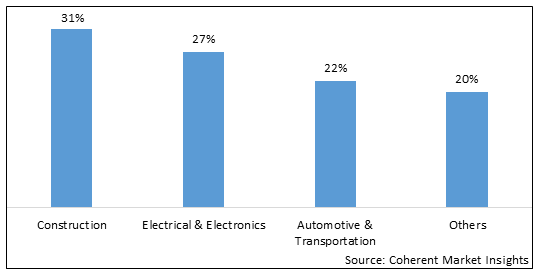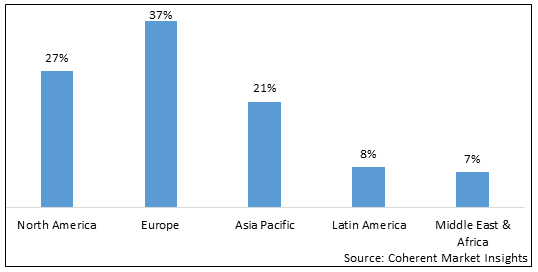Non-Halogenated Flame Retardant Market is estimated to be valued at USD 5.1 Mn in 2025 and is expected to reach USD 8.8 Mn in 2032, exhibiting a compound annual growth rate (CAGR) of 8.15% from 2025 to 2032. The growing construction industry is a major driving factor fueling the market growth of non-halogenated flame retardants. Furthermore, increasing usage of plastic in the automotive industry is expected to augment the market growth of non-halogenated flame retardants.
Global Non-Halogenated Flame Retardant Market - Impact of Coronavirus (COVID-19) Pandemic
The recent coronavirus outbreak negatively affected the market for non-halogenated flame retardant. The severe disruptions in various manufacturing and supply-chain operations caused by various precautionary lockdowns imposed by governments to combat disease spread result in massive financial losses for the market. As a result of the COVID-19 pandemic, the production of electronics parts has been halted due to a logistical bottleneck and a global shortage of manpower. On the other hand, non-essential items (including most electronics products) are no longer being delivered by numerous e-commerce sites around the world, which is harming the electronics industry. This will have a significant impact on the market for non-halogenated flame retardant in the electronics sector, which is the largest market for non-halogenated flame retardant. Additionally, the usage of non-halogenated flame retardant are used in the construction industry, however the shutdown of construction projects is limiting the market growth during the pandemics. Over the forecast period, the described factors will have a negative impact on the market's revenue growth path.
On the positive side, as COVID-19 cases decline, the market is expected to revive as individual regulatory bodies begin to relax these enforced lockdowns. The operations that have been halted and canceled will continue, and as a result, it is anticipated that the market will grow. As a result, the market will recover and grow, following COVID-19.
Global Non-Halogenated Flame Retardant Market: Growth Drivers
Growing construction industry
The growing construction industry is a major driving factor fueling the market growth of non-halogenated flame retardants. Rising usage of the plastic industry as they are the ideal alternative of metal and also saves energy is propelling the demand for plastic in construction industry. The non-halogenated flame is widely used in the production of polymers. According to the Coherent Market Insights analysis, the use of plastic building and construction materials saved 467.2 trillion BTUs of energy over alternative construction materials.

To learn more about this report, Download Free Sample
Increasing usage of plastic in the automotive industry
Increasing usage of plastic in the automotive industry is expected to augment the market growth of non-halogenated flame retardants. Plastic has excellent properties such as corrosion resistance, durability, flexibility and also reduce the overall weight of the automobile making it fuel-efficient. Hence, the growing adoption of plastic in automobiles will favor the market growth of non-halogenated flame retardants over the forecast period.
Global Non-Halogenated Flame Retardant Market: Market Restraints
Volatility in demand and supply of raw materials
Volatility in demand and supply of raw materials used in the production of non-halogenated flame retardant is expected to hamper the market growth over the forecast period. A concern associated with the melamine based flame retardants such as feeding and dosing is expected to hinder the market growth of non-halogenated flame retardants. Hence, the aforementioned factors are expected to negatively impact the market growth to some extent in the future.
Global Non-Halogenated Flame Retardant Market Report Coverage
| Report Coverage | Details | ||
|---|---|---|---|
| Base Year: | 2024 | Market Size in 2025: | USD 5.1 Mn |
| Historical Data for: | 2020 To 2024 | Forecast Period: | 2025 To 2032 |
| Forecast Period 2025 to 2032 CAGR: | 8.15% | 2032 Value Projection: | USD 8.8 Mn |
| Geographies covered: |
|
||
| Segments covered: |
|
||
| Companies covered: |
Key players operating in the Global Non-Halogenated Flame Retardant market includes Clariant International Limited, Albemarle Corporation, Israel Chemical Limited, Italmatch Chemicals S.p.A, Chemtura Corporation, Nabaltec AG, FRX Polymer Inc, Huber Engineered Material, Amfine Chemical Corporation, and THOR Group Ltd |
||
| Growth Drivers: |
|
||
| Restraints & Challenges: |
|
||
Uncover macros and micros vetted on 75+ parameters: Get instant access to report
Global Non-Halogenated Flame Retardant Market: Market Segmentation
On the basis of end user industry, in 2025, construction industry accounted the largest market share of 31% in terms of revenue, followed by electrical & electronics and automobile & transportation, respectively. Non-halogenated flame retardants are widely used in the building products and materials owing to it offers protection from fires. In addition, these non-halogenated retardant is referred as additive which enhance fire and combustion resistance.
Moreover, the flame retardants are widely used in structural insulation in buildings. Thus, this retardant can be applied to building materials, which offer prevention form spread of fire. Owing to these factors, there is increase in demand for non-halogenated flame retardant in construction industry. Moreover, the flame retardants are widely used in structural insulation in buildings.
Figure 2. Global Non-Halogenated Flame Retardant Market, By Region, 2025

To learn more about this report, Download Free Sample
Global Non-Halogenated Flame Retardant Market: Regional Analysis
On basis of the region, Europe region dominated the global evaporation material market, in 2025, accounting for 37% share in terms of volume, followed by North America and Asia Pacific respectively. The increasing usage of non-halogenated flame retardant in electrical and electronics industry in the Europe is driving the market growth. Moreover, non-halogenated flame retardant are widely used in the automotive industry which offers protection from fire. Additionally, the growth of automotive industry in Germany is expected to propel demand for non-halogenated flame retardant during the forecast period.
With around 25% of all passenger vehicles produced and about 20% of all new registrations, Germany is Europe's largest automotive market in terms of sales and production. Aside from that, Germany has Europe's highest concentration of OEM factories. Germany presently has 44 OEM locations there. In the EU, Germany's OEM market share exceeded 55% in 2021.
On the other hand, rising demand for non-halogenated flame retardant from several industries including construction, electrical & electronics, automotive & transportation, and others in North America is bolstering the market growth.
Global Non-Halogenated Flame Retardant Market: Recent Developments
Global Non-Halogenated Flame Retardant Market: Key Companies
Key players operating in the Global Non-Halogenated Flame Retardant market includes Clariant International Limited, Albemarle Corporation, Israel Chemical Limited, Italmatch Chemicals S.p.A, Chemtura Corporation, Nabaltec AG, FRX Polymer Inc, Huber Engineered Material, Amfine Chemical Corporation, and THOR Group Ltd
*Definition: Non-halogenated flame retardants are additives, which lacks halogen and emit less smoke during disposal. Flame-retardant are mainly used across industries which are highly prone to catch fire such as wires and cables, automobiles, circuit boards, electrical and electronic appliances, and textiles. Non-halogenated flame retardants are environmental friendly do not leave a negative impact on environment upon disposal. The market is classified on the basis of product type into metal oxide based, phosphorous based, and nitrogen based. Polyolefin, epoxy resins, UPE, PVC, ETP, rubber, and styrenics are some of the major application areas of non-halogenated flame. Construction, electrical & electronics, and automotive & transportation are some of the major end user of non-halogenated flame retardants.
Share
Share
About Author
Yash Doshi is a Senior Management Consultant. He has 12+ years of experience in conducting research and handling consulting projects across verticals in APAC, EMEA, and the Americas.
He brings strong acumen in helping chemical companies navigate complex challenges and identify growth opportunities. He has deep expertise across the chemicals value chain, including commodity, specialty and fine chemicals, plastics and polymers, and petrochemicals. Yash is a sought-after speaker at industry conferences and contributes to various publications on topics related commodity, specialty and fine chemicals, plastics and polymers, and petrochemicals.
Missing comfort of reading report in your local language? Find your preferred language :
Transform your Strategy with Exclusive Trending Reports :
Frequently Asked Questions
Select a License Type
Joining thousands of companies around the world committed to making the Excellent Business Solutions.
View All Our Clients